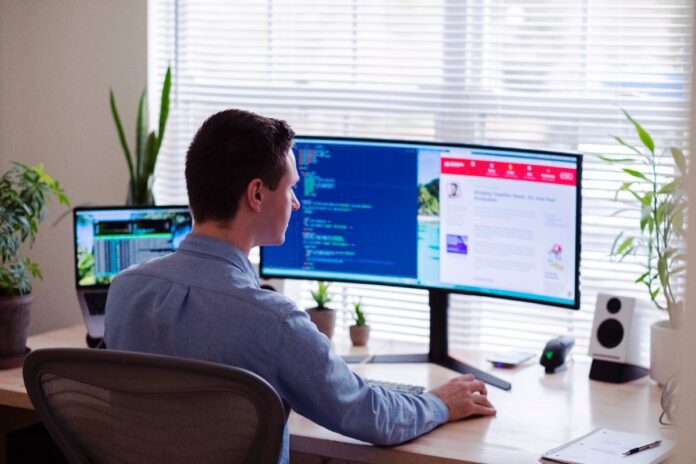
Today, EcoOnline, a technology platform for safer workplaces, reveals the findings from a Hybrid Working Study it conducted in December 2021.
Surveying health & safety professionals from 447 companies, the study suggests half of employers may need to reassess their health and safety provision (protection of health, safety & wellbeing) for hybrid workers. Worryingly, the data reveals that only one in two firms (52%) are providing safety training for staff based partly at home.
Against the context of a shifting societal attitude towards the workplace, and a sharp increase in hybrid working models, these figures highlight how businesses must act now to adequately protect workforces in a more fluid and remote office environment.
This means organisations will have to adapt their approach to accommodate for each individual. For most organisations this home-working and hybrid model will mean a comprehensive risk assessment.
However, while nearly six out of ten firms are planning on carrying out new risk assessments for their hybrid team, there’s a substantial minority (43%) who don’t plan to do so.
Looking at how these assessments will be conducted, one in two will ask employees to fill out a risk-assessment form, while 37% will continue to use their current approaches along with an in-office assessment. A tiny minority (4%) will send health and safety professionals to their colleagues’ homes for an in-person review, and 3% will conduct online video assessments with managers or a H&S practitioner.
There are some gaps between the self-risk assessment provision and subsequent training. As you’d expect, almost all companies are asking about workplace ergonomics (97%) in the risk assessment, but only 14% plan to provide training in correct posture and workstation set-up.
The research found that, when it came to risk assessment, 84% highlighted stress (e.g. from overwork or isolation). While approaching nine out of ten claim managing stress will be covered in the learning sessions, only 10% say their company training covers avoiding isolation specifically and just 2% report that it will look at managing workload and scheduling breaks. However, some training programmes exploring stress or remote communications could well incorporate topics such as isolation and workload management.
Positively, 85% coach colleagues on remote communications. Common topics within the home risk assessment are electrical safety (81%), trip hazards (71%) and fire safety (71%) alongside heating and ventilation (61%).

Ready or not
According to the results of the study, hybrid working is here to stay, yet only one in three are very confident their organisation is fully prepared for the management challenges hybrid working demands. However, only 4% said they were very unconfident that their leadership was ready for the new hybrid world.
Shrinking offices
29% of companies have already decided they’re reducing their office space provision, and 25% have this option on the table. Just under half (47%) are keeping their office estate as it is.
Workplace split
85% of companies expect to have some hybrid workers, with a third (31%) saying that over half of their teams will be hybrid. Despite the media conversation, presuming the prevalence of this mode of working, 15% of organisations will have no hybrid workers and around one in five will have less than 10% of their team splitting their time between home and work.
This shows a rapid change in working practices when we compare how most companies operated pre-pandemic: a third (36%) had no hybrid workers at all and four in ten had under 10% of their team working in this way.
When we examine the exact split between home and work there’s quite a variance. In just over half of organisations (57%), the home office split will vary by agreement with line managers or depending on business needs, rather than follow a regular pattern.
Not for all
17% of companies had declined requests for hybrid working, mainly due to space or home set up. Other reasons cited for having turned down hybrid working requests included isolation, back pain and mental health & wellbeing concerns.
Commenting on the study, Dr Catherine Jordan, Health & Safety Product Specialist, EcoOnline said, “Employers need to remember that their duty of care for their people’s health, safety and wellbeing extends to the at-home part of their working lives. Managing the blend of home and office working requires planning and communication. Risk assessment is an important precursor to any new working arrangement, but it is only one consideration in the successful management of worker safety, health and wellbeing.”
She added, “While the experience of the past two years has been seminal, it will only partly prepare workers and organisations for the changes now underway. Those businesses most likely to thrive in a hybrid working future will have; risk assessed the implications of a hybrid work model and the suitability of individuals’ homes for extended working, provided the right equipment and provided training in the planned approach, updated procedures and guidance to managing the safety, health & welfare of all in the new and changing world of work.
447 companies participated in the research, and most of the respondents were health and safety professionals.
Help keep news FREE for our readers
Supporting your local community newspaper/online news outlet is crucial now more than ever. If you believe in independent journalism, then consider making a valuable contribution by making a one-time or monthly donation. We operate in rural areas where providing unbiased news can be challenging. Read More About Supporting The West Wales Chronicle


























